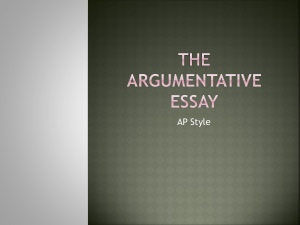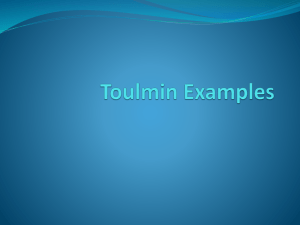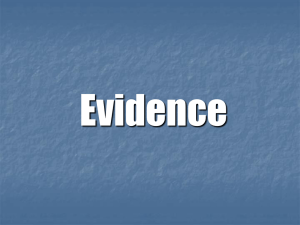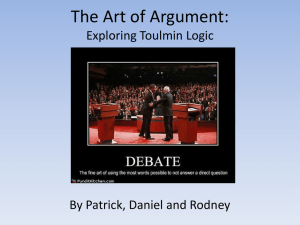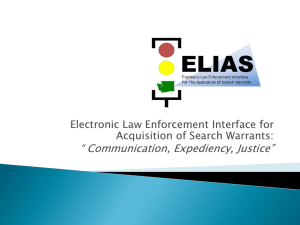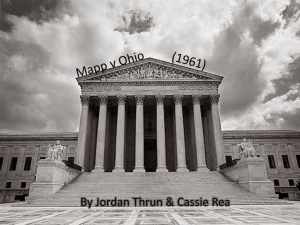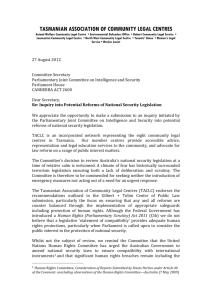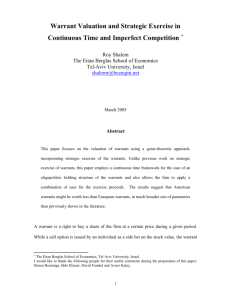Lec 15: The hierarchy of intersection control
advertisement
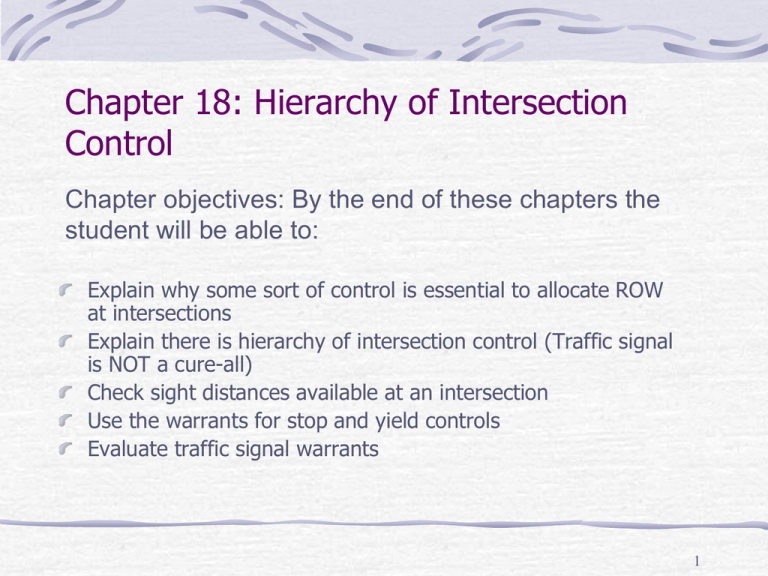
Chapter 18: Hierarchy of Intersection Control Chapter objectives: By the end of these chapters the student will be able to: Explain why some sort of control is essential to allocate ROW at intersections Explain there is hierarchy of intersection control (Traffic signal is NOT a cure-all) Check sight distances available at an intersection Use the warrants for stop and yield controls Evaluate traffic signal warrants 1 Conflict points at unsignalized intersections T intersection 4-leg intersection Total = 32 Crossing = 3 Merging = 3 Diverging = 3 Total = 9 2 Two factors affecting a driver’s ability to avoid conflicts 1. A driver must be able to see a potentially conflicting vehicle or pedestrian in time to implement an avoidance maneuver, (sight distance related) and 2. The volume levels that exist must present reasonable opportunities for a safe maneuver to take place (gap availability related). 3 The Hierarchy of Intersection Control Intersection Control Options: How much judgment can drivers safely exercise to avoid collisions? Three levels of control are available. Level I Passive control – basic rules of the road apply No control Guide signs only Warning signs with or without guide signs Level II Direct assignment of ROW to major street or rotational ROW YIELD control (roundabouts are in this category) Two-way STOP control All-way STOP control Level III Positive alternate assignment of exclusive ROW Traffic signals: 2-phase, multiphase Traffic control agent/officer 4 18.1 Level I Control: Basic rules of the Road Primary prerequisite for safety under basic rules-of-the-road: Sight distance must be adequate for the driver before he is accountable for full responsibility for his action. The first thing you want to check is whether adequate SSD is available at the intersection. This must be satisfied before traffic volume concerns come into consideration. b From the similarity of triangles (1-3-2 and 6-4-5): dB a ab dA b ab How do you determine dA and dB? “Visibility Triangle: Veh A is on minor street” dA b dA b a dB a a dB ab ad A ab dA b dB ad dB A dA b 5 Rule 1: Both vehicles have at least one safe SSD to the collision point (AASHTO recommended), p.412 Step 1: Assume that Vehicle A (on minor street) is located one safe SSD from the collision point. Usually the vehicle is considered to be on the minor 2 road. SA d A 1 . 47 S A t 30 0 . 348 0 . 01 G Step 2: Based on the assumed position, determine the actuallocation of Vehicle B when it first becomes visible. Call it dB(act) dB ad A dA b Step 3: Rule 1 requires Vehicle B (on major street) to have one safe SSD. Call it dB(min). 2 d B min 1 . 47 S B t SB 30 0 . 348 0 . 01 G Step 4: If dBact dBmin, then adequate SSD for basic rules-of-the-road has been provided. Otherwise, violated and under Rule 1, not safe. 6 Rule 2: Vehicle A must travel 18 feet past the collision point in the same time that Vehicle B travels to a point 12 feet before the collision point, p.412 (Historically, another approach…) d A 18 dB 1 . 468 S A d B 12 1 . 468 S B d B d A 18 dA SB 12 SA This dB is used in Step 3 in Rule 1. The remaining steps are the same as Rule 1. 7 When dBact < dBmin then operation with no control cannot be permitted. Implement intersection control, using STOP- or YIELD-control, or traffic signals. Lower the speed limit on the major street to a point where sight distances are adequate. Remove or reduce sight obstructions to provide adequate sight distances. 8 Sample problem: Fig. 18.3, p.412 Step 1: d A 1 . 47 ( 30 )( 2 . 5 ) 2 196 . 5 ft 30 ( 0 . 348 ) Step 2: dB d Bact b dA ( 30 ) ad A dA b ( 20 )( 196 . 5 ) 196 . 5 42 25 . 4 ft Step 3: d B min, R 1 1 . 648 ( 40 )( 2 . 5 ) a d B min, R 2 (196 . 5 18 ) 40 ( 40 ) 2 300 . 3 ft 30 ( 0 . 348 ) 12 298 . 0 ft 30 Step 4: The sight triangle between Vehicle A and B fails to meet the criteria for safe operation under basic rules of the road. dBact << dBmin,R1 and dBmin,R2 Both rules were violated. 9 Apply the concept you just learned. There are 4 steps to solve this problem. Remember as long as one side is unsafe, rules of the road cannot be used as the only form of control. 10 18.2 Level II Control: Yield and STOP Control YIELD or STOP control? Remember the critical approach speed (CAS) method we studied in CE361?, section 8.1.2 of Fricker’s text book? If CAS is between 10 to 15 mph, use YIELD. If less than 10 mph, use STOP. http://mutcd.fhwa.dot.gov/HTM/2003r1/part2/part2b1.htm 11 18.2.1 Twoway stop sign http://mutcd.fhwa.dot.gov/HTM/2003r1/part2/part2b1.htm 12 Stop Control: Sample Problem: Figure 18.4 18ft = (10 ft from the edge of curb to the stop line) + (8 ft form the front bumper to the driver) dA-STOP = 18 + dcl dcl = Distance from the curb line to the center of the closest travel lane from the direction under consideration (ft): cl = curb line. (because LTs must enter the median lane.) dBmin = 1.47*Smaj*tg 36! dB dB ad A ad dA b dA b So, what do you have to do with this result? A 13 18.2.2 Yield control YIELD Table 18.3: Warrants for YIELD sign 14 18.2.3 Multiway-way stop control 15 18.3 Level III Control: Traffic Control Signals While warrants and other criteria for STOP and YIELD signs are somewhat general in the MUTCD, warrants for signals are quite detailed. 18.3.1 Advantages of traffic signal control Provide for the orderly movement of traffic Increase the traffic-handling capacity of the intersection if applied properly and physical layout is conducive Reduce the frequency and severity of certain types of crashes, esp. right-angle collisions Provide for continuous or nearly continuous movement at a definite speed when coordinated (by coordination) Used to interrupt heavy traffic at intervals to permit other traffic, vehicular or pedestrian, to cross http://mutcd.fhwa.dot.gov/HTM/2003r1/part4/part4c.htm 16 18.3.2 Disadvantages of traffic signal control 1. Excessive delay (when timing is improper) 2. Excessive disobedience of the signal indications (when red interval is improperly long) – may encourage red-light running 3. Increased use of less adequate routes as road users attempt to avoid the traffic control signal 4. Significant increases in the frequency of collisions (especially rear-end collisions) 17 18.3.3 Warrants for traffic signals Data requirements 1. 2. 3. 4. 5. Traffic volumes in each approach, at least 12 consecutive hours (24 hrs count preferred) containing the highest % of 24-hour traffic (include two peak periods) 15-min counts by approach and movement classified by vehicle type during the 2 hours in the AM and PM peak periods (4 hours total) Pedestrian counts in each crosswalk during the same 4 hours in item 2 Information on nearby facilities and centers serving the movement disadvantaged (young, elderly, or disabled) Posted or statutory speed limit and/or the 85the percentile speed 6. A condition diagram (ch.11) 7. A collision diagram (ch.11) 8. For the two peak AM and two peak PM hours: a) Vehicle-hours of stopped delay for each approach b) Number and distribution of gaps c) Speed limits d) Pedestrian delays for at least two 30 minute peak pedestrian delay periods e) Queue lengths on STOPcontrolled approaches (See page 418 and 419.) 18 Warrants for Traffic Signals MUTCD 2009 has 9 warrants for a traffic signal. They are guides, not specs. Use professional judgments. Warrant 1: Eight-hour vehicular volume (1a: minimum traffic volume; 1b: interruption of traffic; 1c: combination of warrants) Warrant 2: Four-hour vehicular volume Signals Warrant 3: Peak hour Warrant 4: Pedestrian volume Warrant 5: School crossing Warrant 6: Coordinated signal system Warrant 7: Crash experience Warrant 8: Roadway network Warrant 9: Intersection near a highway-rail crossing 19 Signal warrant 1A: 8-hour volume Min. vehicle volume: Principal factor is the intersection traffic volume. Must satisfy for each of any 8 hour of an average day (they do not need to be consecutive 8 hours). May reduce the values by 30% if the 85th percentile speed on the major approach is greater than 40 mph or population is less than 10,000 (built-up area of isolated community). 20 Where do these values come from? My guess is… Use the random arrival case and use the Poisson distribution. 21 Signal warrant 1B Interruption of continuous traffic: The volume requirements must be met for each of any 8 hours of an average day. May reduce the values by 30% if the 85th percentile speed on the major approach is greater than 40 mph or population is less than 10,000 (built-up area of isolated community). 22 Signal warrant 1C Combination of warrants: Only in exceptional cases. When none of the warrants are satisfied but when the first two warrants of Warrant 1 are satisfied to the extent of 80% of the stipulated volumes. 23 Signal warrant 2: 4-hour volume Check for each of any 4 hr of an average day. To meet the warrant , at least four hours must plot above the appropriate decision curve. 24 Signal warrant 3: Peak-hour volume Justified where traffic condition during 1 hr of the day result in undue delay to traffic on the minor street. (factories, office park etc.) 25 Or Signal warrant 3B: delay This applies to cases in which STOP control is already in effect for the minor road. Cannot jump from no-control or YIELD to signals. 26 Warrant 4: Pedestrians (4 hours) (a) Normal criteria (b) Pop < 10,000, major road speed exceeds 35 mph If a signal is warranted only by this warrant, start with a semi-actuated signal. A full actuated signal is possible at an isolated intersection. Another one nearby < 300 ft? Then, this warrant is not met. May be reduced as much as by 50% if majority of walkers walk at less than 3.5 mph. Fig. 18-7 27 Or, Warrant 4: Pedestrians (peak hour) Fig. 18.8 28 Warrant 5: School Crossing Warrant 5: School Crossing. The frequency of occurrence of gaps and the lengths of gaps are inadequate for safe crossing of the street. The number of acceptable gaps is less than the number of minutes in that period, e.g., if the crossing lasts 30 minutes, there must be at least 30 occurrence of critical gaps for children to cross. The minimum number is 20 during the highest crossing hour. If only this warrant is met, use a pedestrian-actuated signal. 29 Warrant 6: Coordinated System This should not result in signal spacing of less than 1,000 ft. 30 Signal warrant 7: Crash Experience Warrant 7: Crash Experience. Less restrictive measures must be used before this warrant is used. 5 or more injury or property-damageonly accidents within a 12month period, AND signal control is a suitable countermeasure. AND, the traffic and pedestrian volumes should not be less than 80% of the requirements of warrants 1A and 1B (See Table 18.5 for details). 31 Signal Warrant 8: Roadway Network Warrant 8: Roadway Network. When lights help to encourage concentration and organization of traffic networks. (1) The total existing or immediately projected volume is at least 1000 during the peak hour AND the 5-year projected traffic volumes satisfy the requirements of one or more of the Warrants 1, 2, 3, on average weekday, OR (2) The total existing or projected entering volume is at least 1000 vehicles for each of any 5 hr of a Saturday and/or a Sunday. See Table 18.9 for details. 32 Signal warrant 9: Intersection Near a Highway-Rail Grade Crossing 33 One lane approach The minor-street volume used in entering either Figure18.9 or 18.10 may be multiplied by up to three adjustment factors: (1) for train volume, (2) for presence of high-occupancy buses, more than 20 passengers, and (3) for truck presence. 34 Two lane approach The minor-street volume used in entering either Figure18.9 or 18.10 may be multiplied by up to three adjustment factors: (1) for train volume, (2) for presence of high-occupancy buses, more than 20 passengers, and (3) for truck presence. 35 The minor-street volume used in entering either Figure18.9 or 18.10 may be multiplied by up to three adjustment factors: (1) for train volume, (2) for presence of high-occupancy buses, more than 20 passengers, and (3) for truck presence. 36 37 38 18.3.5 A sample problem in application of signal warrants We will walk through 18.3.5 in class 39
